
|
Astronomy Picture Of the Day (APOD)
 Supermoon and Space Station
Supermoon and Space Station
13.11.2016
What are those specks in front of the Moon? They are silhouettes of the International Space Station (ISS). Using careful planning and split-second timing, a meticulous lunar photographer captured ten images of the ISS passing in front of last month's full moon.
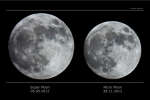 Super Moon vs Micro Moon
Super Moon vs Micro Moon
12.11.2016
What is so super about tomorrow's supermoon? Tomorrow, a full moon will occur that appears slightly larger and brighter than usual. The reason is that the Moon's fully illuminated phase occurs within a short time from perigee - when the Moon is its closest to the Earth in its elliptical orbit.
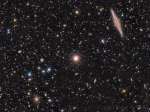 NGC 891 vs Abell 347
NGC 891 vs Abell 347
11.11.2016
Galaxies abound in this well-chosen field of view that spans about 1 degree on the sky toward the northern constellation Andromeda. At top right is large spiral galaxy NGC 891, 100 thousand light-years across and seen almost exactly edge-on.
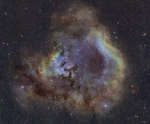 NGC 7822 in Cepheus
NGC 7822 in Cepheus
10.11.2016
Hot, young stars and cosmic pillars of gas and dust seem to crowd into NGC 7822. At the edge of a giant molecular cloud toward the northern constellation Cepheus, the glowing star forming region lies about 3,000 light-years away. Within the nebula, bright edges and dark shapes stand out in this colorful skyscape.
 Great Rift Near the Center of the Milky Way
Great Rift Near the Center of the Milky Way
9.11.2016
Over 100 telescopic image panels in this stunning vertical mosaic span about 50 degrees across the night sky. They follow part of the Great Rift, the dark river of dust and molecular gas that stretches along the plane of our Milky Way Galaxy.
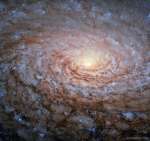 M63: The Sunflower Galaxy from Hubble
M63: The Sunflower Galaxy from Hubble
8.11.2016
One of the bright spiral galaxies visible in the north sky is M63, the Sunflower Galaxy. M63, also catalogued as NGC 5055, can be found with a small telescope toward the constellation of Hunting Dogs (Canes Venatici).
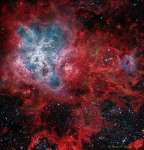 The Cosmic Web of the Tarantula Nebula
The Cosmic Web of the Tarantula Nebula
7.11.2016
It is the largest and most complex star forming region in the entire galactic neighborhood. Located in the Large Magellanic Cloud, a small satellite galaxy orbiting our Milky Way galaxy, the region's spidery appearance is responsible for its popular name, the Tarantula nebula. This tarantula, however, is about 1,000 light-years across.
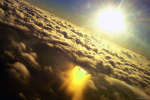 Inverted City Beneath Clouds
Inverted City Beneath Clouds
6.11.2016
How could that city be upside-down? The city, Chicago, was actually perfectly right-side up. The long shadows it projected onto nearby Lake Michigan near sunset, however, when seen in reflection, made the buildings appear inverted.
 Starburst Cluster in NGC 3603
Starburst Cluster in NGC 3603
5.11.2016
A mere 20,000 light-years from the Sun lies NGC 3603, a resident of the nearby Carina spiral arm of our Milky Way Galaxy. NGC 3603 is well known to astronomers as one of the Milky Way's largest star-forming regions.
 ISS Fisheye Flythrough
ISS Fisheye Flythrough
4.11.2016
Shot in Ultra HD, this stunning video can take you on a tour of the International Space Station. A fisheye lens with sharp focus and extreme depth of field provides an immersive visual experience of life in the orbital outpost.
|
January February March April May June July August September October November December |
|||||||||||||||||||||||||||||||||||||||||||||||||